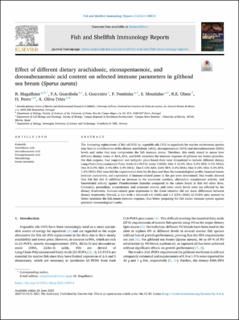| dc.contributor.author | Magalhaes, R. | |
| dc.contributor.author | Guardiola, F.A. | |
| dc.contributor.author | Guerreiro, I. | |
| dc.contributor.author | Fontinha, F | |
| dc.contributor.author | Moutinho, Sandra | |
| dc.contributor.author | Olsen, Rolf Erik | |
| dc.contributor.author | Peres, H. | |
| dc.contributor.author | Oliva-Teles, A. | |
| dc.date.accessioned | 2023-02-22T10:57:11Z | |
| dc.date.available | 2023-02-22T10:57:11Z | |
| dc.date.created | 2021-08-10T15:53:46Z | |
| dc.date.issued | 2021 | |
| dc.identifier.citation | Fish & Shellfish Immunology Reports. 2021, 2 . | en_US |
| dc.identifier.issn | 2667-0119 | |
| dc.identifier.uri | https://hdl.handle.net/11250/3053173 | |
| dc.description.abstract | The increasing replacement of fish oil (FO) by vegetable oils (VO) in aquafeeds for marine carnivorous species may lead to modifications of the dietary arachidonic (ARA), eicosapentaenoic (EPA) and docosahexaenoic (DHA) levels and ratios that may compromise the fish immune status. Therefore, this study aimed to assess how different dietary ratios of ARA, EPA, and DHA modulate the immune response of gilthead sea bream juveniles. For that purpose, four isoproteic and isolipidic plant-based diets were formulated to include different dietary Long-Chain-Polyunsaturated Fatty Acids (LC-PUFA) ratios (%DM): Diet A (2.0% ARA: 0.2% EPA: 0.1% DHA); Diet B (1.0% ARA: 0.4% EPA: 0.4% DHA); Diet C (0% ARA: 0.6% EPA: 0.6% DHA); Diet D (0% ARA: 0.3% EPA: 1.5% DHA). Fish were fed the experimental diets for 56 days and then the haematological profile, humoral innate immune parameters, and expression of immune-related genes in the gut were determined. Our results showed that fish fed diet B exhibited an increase in the monocyte numbers, alternative complement activity, and bactericidal activity against Photobacterium damselae compared to the values found in fish fed other diets. Contrarily, peroxidase, antiproteases, and proteases activity and nitric oxide levels were not affected by the dietary treatments. Immune-related gene expression in the distal intestine did not show differences between dietary treatments. Overall, a diet with a balanced n-6 (ARA) and n-3 (EPA+DHA) LC-PUFA ratio seemed to better modulate the fish innate immune response, thus better preparing the fish innate immune system against potential immunological insults. | en_US |
| dc.language.iso | eng | en_US |
| dc.publisher | Elsevier B. V. | en_US |
| dc.rights | Navngivelse 4.0 Internasjonal | * |
| dc.rights.uri | http://creativecommons.org/licenses/by/4.0/deed.no | * |
| dc.title | Effect of different dietary arachidonic, eicosapentaenoic, and docosahexaenoic acid content on selected immune parameters in gilthead sea bream (Sparus aurata) | en_US |
| dc.title.alternative | Effect of different dietary arachidonic, eicosapentaenoic, and docosahexaenoic acid content on selected immune parameters in gilthead sea bream (Sparus aurata) | en_US |
| dc.type | Peer reviewed | en_US |
| dc.type | Journal article | en_US |
| dc.description.version | publishedVersion | en_US |
| dc.source.volume | 2 | en_US |
| dc.source.journal | Fish & Shellfish Immunology Reports | en_US |
| dc.identifier.doi | 10.1016/j.fsirep.2021.100014 | |
| dc.identifier.cristin | 1925170 | |
| dc.source.articlenumber | 100014 | en_US |
| cristin.ispublished | true | |
| cristin.fulltext | original | |
| cristin.qualitycode | 1 | |

